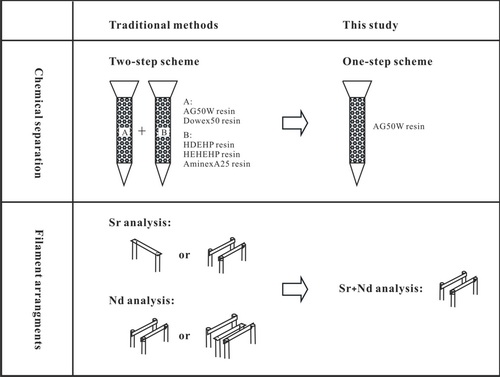The 87Sr / 86Sr and 143Nd / 144Nd ratios are widely used in geochemical tracing and petrological studies. In order to obtain accurate ratios of 87Sr / 86Sr and 143Nd / 144Nd, the traditional method needs to separate pure Sr and Nd by two-step ion exchange technology, and then use a thermal ionization mass spectrometer (TIMS) for testing. That is, the dissolved sample solution is first passed through a cation exchange column (AG50W-X8 / 12) to remove the matrix, at the same time, pure Sr is separated, and rare earth (REEs) is recovered, and then a leaching resin exchange column (P507 / 204 or LN) is used Pure Nd is separated from rare earth. Finally, pure Sr and Nd are coated on different filaments and tested by TIMS.
Although the traditional TIMS analysis scheme has extremely high accuracy and test accuracy, the traditional scheme is time-consuming and labor-intensive, and the experiment cost is high. There are two aspects: (1) The TIMS ion source cannot be tested directly at atmospheric pressure. Only a limited number of samples (13 to 21 pieces) can be installed in the sample chamber at a time. After these samples are analyzed, the next batch can be loaded For the sample to be tested, this will consume a lot of time (> 3 hours) for evacuation. In addition, the tedious operation steps (filament cleaning, spot welding, degassing and spotting) will consume a lot of labor, which greatly restricts the working capacity of the laboratory. (2) The high-purity filament materials (Re, Ta, W) used for sample testing are all disposable, and currently rely mainly on imports, which are expensive, and the large amount of filament consumption increases the experimental cost.
Li Chaofeng, a senior engineer and collaborator of the Solid Isotope Laboratory, Institute of Geology and Geophysics, Chinese Academy of Sciences, used Triton TIMS mass spectrometer to try to analyze the mixed fraction of strontium and rare earth, that is, to recover strontium and rare earth in one step, and directly apply the evaporated sample Coated on the rhenium filament, using TIMS to sequentially determine the ratio of Sr and Nd isotopes on the same filament. The stability and reliability of the method are evaluated using a series of international rock standards, and the analysis results are consistent with traditional methods. This method significantly improves the analysis efficiency and greatly expands the working capacity of the laboratory.
Specifically, there are four advantages of this method: (1) The traditional two-step preparation is simplified into one step, which saves 1 time of preparation; (2) No need to deflate the ion source, and the sequential determination of Sr-Nd saves 1 time. Vacuum time; (3) The amount of filament is reduced by a factor of two, and the test cost is greatly reduced; (4) The cumbersome experimental preparation work (filament cleaning, spot welding, degassing and spotting) is simplified by a factor of two, and the labor consumption is reduced by a factor of two.
The research results were recently published in the international analytical chemistry journal Analytica Chimica Acta (Li et al. Rapid and precise determination of Sr and Nd isotopic ratios in geological samples from the same? Lament loading by thermal ionization mass spectrometry employing a single-step separation scheme. Analytica Chimica Acta. 2012, 727: 54-60)
 BRIEF DESCRIPTION OF THE DRAWINGS: This technology is analogous to traditional analysis solutions
BRIEF DESCRIPTION OF THE DRAWINGS: This technology is analogous to traditional analysis solutions
Electric Pressure Cooker,Best Pressure Cooker,Instant Pot Pressure Cooker,Presto Pressure Cooker
Fungho Industries (Group) Co., Limited , https://www.funghogroup.com
